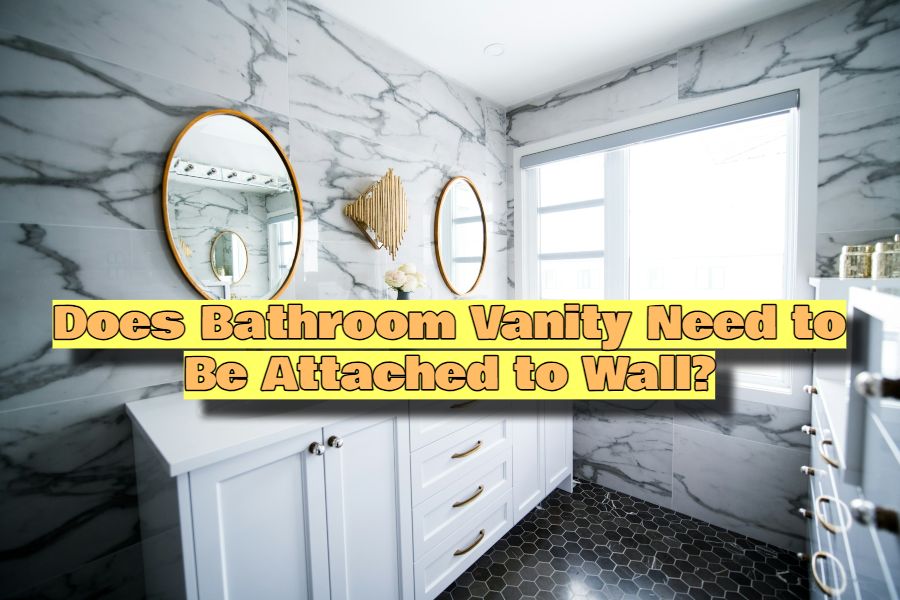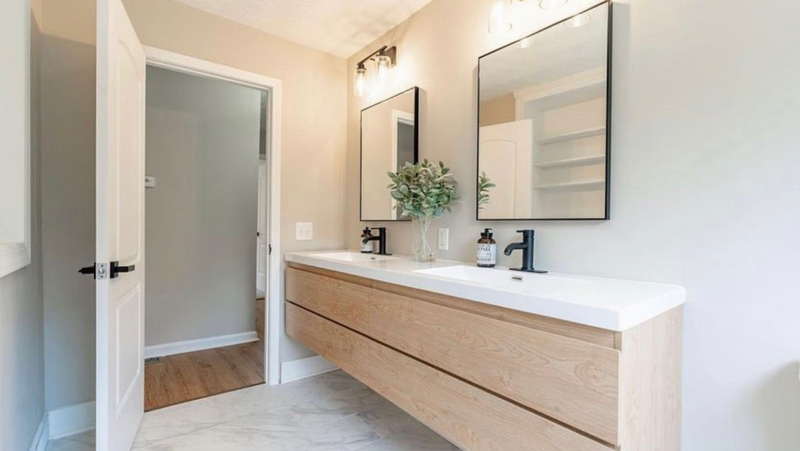
Bathroom vanities do not always need to be attached to the wall. Freestanding vanities can be a flexible option for many bathrooms.
Selecting the right type of bathroom vanity is crucial for both aesthetic appeal and functionality. Homeowners often ponder whether bathroom vanities must be anchored to the wall. While wall-mounted vanities are common and provide stability and permanent placement, not every vanity requires wall attachment.
Freestanding vanities offer the freedom to move the piece when renovating or altering bathroom layouts. The choice between a freestanding or wall-attached vanity depends on personal preference, bathroom size, and design considerations. Understanding this allows individuals to make informed decisions when designing or remodeling their bathroom spaces, ensuring that their choice complements their personal style and bathroom requirements.

Credit: www.amazon.com
Bathroom Vanity Stability
Bathroom vanities anchor the room’s design while providing practical storage space.
Varying installation types influence stability and functionality.
Freestanding Vs Wall-mounted
Freestanding vanities stand on the floor and often require less installation effort.
They offer flexibility in placement and ease of movement during remodels.
| Freestanding Advantages | Wall-Mounted Advantages |
|---|---|
| Ease of installation | Clean, modern look |
| Portability | Space-saving |
| Versatile designs | Enhanced floor clearance for cleaning |
Wall-mounted vanities, also known as floating vanities, attach to the wall with special mounting hardware.
This requires sturdy wall support but offers a seamless and contemporary appearance.
Potential Movements And Risks
- Freestanding vanities may shift if not anchored properly.
- This can lead to misalignment or damage.
- Wall-mounted models eliminate these issues.
- They require correct installation to manage weight and prevent detachment.
Both types need consideration for plumbing alignment and secure attachment.
Installation Requirements
Before falling in love with a bathroom vanity design, consider the practical aspects. Does it need to be fixed to a wall? Not all vanities require wall attachment. However, certain factors like safety, stability, and local regulations often necessitate securing the vanity in place.
Building Codes And Regulations
Start with local building codes. These rules ensure safe and proper installation. Your area might have specific mandates.
- Check local requirements for bathroom fixtures.
- Seek permits if needed.
- Understand the implications of non-compliance.
Structural Support And Constraints
A sturdy installation keeps the vanity and users safe. Think about the weight and size of the unit. Will the wall handle it? Main support comes from strong wall studs.
- Assess wall material and stud placement.
- Prepare for additional support if the vanity is heavy.
- Consider access to plumbing during installation.
Note: Free-standing vanities might not need wall support. Yet, they need proper anchoring to prevent tipping.
Design Preferences And Layout
When planning your bathroom renovation, consider if a vanity needs wall attachment.
Design preferences and layout play crucial roles in this decision.
Some vanities look great standing alone, offering flexibility and ease of installation.
But for others, securing to the wall is key for both stability and space efficiency.
Let’s explore how both aesthetics and space optimization can influence your choice.
Aesthetic Considerations
A vanity’s appeal can change a bathroom’s look and feel. Freestanding vanities might be your pick for a classic or vintage style.
They add character and can become a room’s centerpiece. But, wall-mounted vanities suggest a modern and sleek touch, floating above the floor.
This design can make small bathrooms appear larger and more open.
Space Optimization Strategies
Space use is essential in bathroom layouts, especially in smaller ones. Wall-mounted vanities often help save floor space, allowing for additional storage underneath.
- Corner vanities utilize often ignored spaces.
- Narrow depth vanities preserve room to move.
- Double sink vanities maximize functionality.
Think about your storage needs and daily routines. A wall-attached vanity can offer clever built-in solutions, such as hidden drawers and shelves.
Always measure your space carefully to ensure a good fit.

Credit: www.wayfair.com
Safety Concerns
Safety Concerns play a pivotal role when installing bathroom vanities. A free-standing vanity can look appealing. Yet, firmly attaching it to a wall secures safety and prevents accidents. Below, we dive into why mounting your vanity is more than just an aesthetic choice.
Preventing Tipping Hazards
Unsecured vanities pose a risk, especially in homes with children. Kids often see vanities as a climbing opportunity. A secured vanity counters this risk. Here’s how a fixed vanity ensures safety:
- Stability: Wall-mounted vanities resist accidental knocks.
- Security: Proper installation means less wobble, reducing fall risk.
- Peace of Mind: Confidently store heavy items knowing the vanity won’t tip.
Water Damage And Mold Prevention
In a bathroom, moisture is ever-present. Water can cause damage when it seeps under unattached vanities. Here are the benefits of attachment for water and mold prevention:
| Benefit | Description |
|---|---|
| Circulation | Ensures air flows under the unit, drying any residual moisture. |
| Cleanability | Makes it easier to spot and clean spills and leaks promptly. |
| Protection | Reduces the chance of wood rot and mold formation. |
Remember, a well-anchored vanity minimizes these concerns, contributing to a safer, cleaner bathroom.
Practical Installation Tips
Anchoring a bathroom vanity to the wall boosts stability, ensuring a safe and enduring setup. Consider these practical installation tips to ensure a smooth attachment process.
Tools And Materials Overview
Collect the right tools and materials before you start. Here’s what you’ll need:
- Drill – to make holes
- Screws and Wall Anchors – to secure the vanity
- Stud Finder – to locate wall studs
- Level – to ensure the vanity is straight
- Pencil – to mark drill spots
- Tape Measure – to measure space
Step-by-step Attachment Process
- Locate Wall Studs: Use the stud finder to find studs. Mark the spots with a pencil.
- Position Vanity: Place the vanity against the wall. Make sure it’s level.
- Mark Drill Points: Mark through the vanity’s mounting holes onto the wall.
- Drill Holes: Use the drill to create holes where you marked.
- Insert Wall Anchors: Tap anchors into the holes if no studs are present.
- Attach Vanity: Line up the vanity with the holes. Secure with screws.
- Final Checks: Ensure the vanity is firm and level. Make adjustments if needed.

Credit: morenobath.com
Frequently Asked Questions Of Does Bathroom Vanity Need To Be Attached To Wall
How Do You Secure A Freestanding Vanity?
To secure a freestanding vanity: Locate wall studs, align the vanity’s back rail, drill pilot holes, and fasten with screws. Ensure the vanity remains level throughout installation.
Do Freestanding Vanities Need To Be Secured To Wall?
Yes, freestanding vanities generally require securing to the wall for stability and to prevent tipping over. This ensures safety and durability in your bathroom.
Should Bathroom Vanity Be Flush With Wall?
A bathroom vanity does not need to be flush with the wall. There should be enough space for proper ventilation and to accommodate uneven walls or plumbing configurations. Always ensure a snug fit without compromising on functionality.
Should I Leave A Gap Between Vanity And Wall?
Yes, leave a small gap between a vanity and a wall to allow room for expansion and prevent moisture damage. Caulk can seal the space if needed.
Conclusion
Attaching a bathroom vanity to the wall is a choice that ensures stability and longevity. For those prioritizing aesthetics or in need of mobility, alternatives do exist. Consider your bathroom’s design and daily use to make the best decision for your home.
Remember, safety and function should always guide your choice.




















